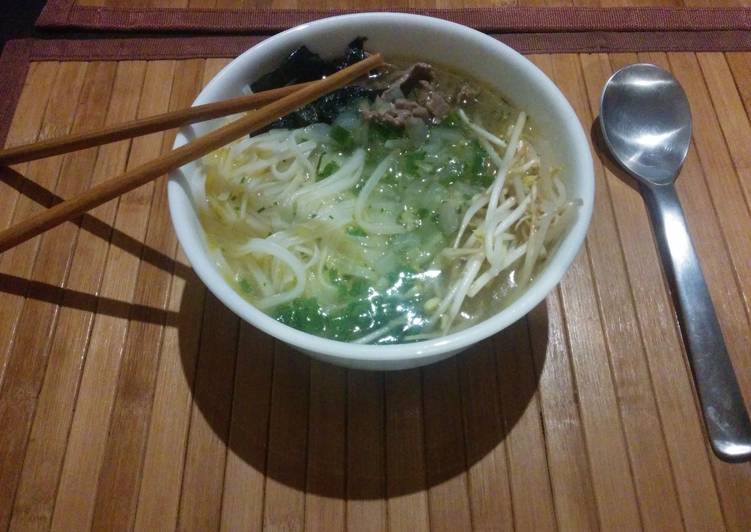
Hello everybody, it’s me again, Dan, welcome to our recipe site. Today, we’re going to prepare a distinctive dish, traditional japanese ramen (with beef). One of my favorites. For mine, I am going to make it a bit unique. This is gonna smell and look delicious.
We Have Almost Everything on eBay. The other half of Ramen is the soup. Generally speaking, there are three basic types of Ramen soups: Shyoyu (soy sauce), Miso, and Shio (salt). Usually pork, chicken or seafood broth is used for the base of the soup, and that is then seasoned with soy sauce, miso, or salt.
Traditional Japanese Ramen (with beef) is one of the most favored of current trending foods in the world. It is enjoyed by millions every day. It is easy, it is quick, it tastes delicious. They are fine and they look fantastic. Traditional Japanese Ramen (with beef) is something that I’ve loved my whole life.
To get started with this particular recipe, we must prepare a few ingredients. You can have traditional japanese ramen (with beef) using 16 ingredients and 7 steps. Here is how you cook that.
The ingredients needed to make Traditional Japanese Ramen (with beef):
- Prepare broth
- Make ready 1 1/2 liter chicken broth
- Prepare 1 tbsp ginger, finely chopped
- Get 1 tbsp red pepper, finely chopped (optional, if you like spicy)
- Prepare 2 tbsp chives, finely chopped
- Make ready 2 tbsp soy sauce
- Take 4 tbsp sesame oil
- Get 2 garlic cloves, finely chopped
- Get 4 grams Hondashi soup stock
- Prepare 2 tbsp scallion tails (finely chopped)
- Prepare dish
- Make ready 300 grams Rice ramen
- Make ready 4 tbsp scallions (just the tails), finely chopped
- Prepare 1 Nori (sushi seaweed) cut in small strips (1x3cm)
- Get 2 thin beef steaks, cut in small pieces
- Get 200 grams bean sprouts
This is a really easy basic ramen and it's really delicious! Gather the pans/pots that you're going to use and everything else. Shoyu ramen soup is a clear, brown broth flavored with soy sauce (shoyu). The soup is usually made of chicken broth but often contains other meats such as pork, beef or fish depending on the region.
Instructions to make Traditional Japanese Ramen (with beef):
- Prepare all ingredients (chop, cut, etc.)
- Start boiling the chicken broth.
- Meanwhile, heat a pan with the sesame oil, and start cooking the garlic for 1 minute (until golden.) Then add to the pan the soy sauce, 2tbsp of the scallion tails, the chopped chives, the ginger and the red pepper. Cook for ~2 minutes. This will your ramen broth seasoning.
- Pour into the boiling chicken broth the ramen seasoning that you cooked in step 3. Also add the Hondashi soup stock. Keep boiling and stirring the broth for 10 more minutes.
- Meanwhile put the rice ramen in plain boiling water. It will take about 3 or 4 minutes to cook. It should be "al dente." Once cooked, rinse it with cold water to stop the cooking process.
- Prepare the plate: In a deep soup plate put some rice ramen, some 1 tbsp of the remaining scallions, some bean sprouts, 1/4 of the beef and some Nori leave pieces. TIP: try to accommodate these ingredients in the same way for all plates: just looks nice… :)
- Just before serving, pour the prepared broth to fill the plate to serve. Enjoy!
Shoyu ramen soup is a clear, brown broth flavored with soy sauce (shoyu). The soup is usually made of chicken broth but often contains other meats such as pork, beef or fish depending on the region. Shoyu ramen is the most common type of ramen and is usually what is served when the menu does not specify a specific type of soup. Usually, for beef chashu, the bottom round is used, while for chicken and duck chashu, the breast is most often used. Chashumen is used to refer to a ramen that contains a lot of chashu.
So that is going to wrap this up for this exceptional food traditional japanese ramen (with beef) recipe. Thank you very much for reading. I’m confident that you will make this at home. There’s gonna be interesting food in home recipes coming up. Remember to bookmark this page on your browser, and share it to your loved ones, colleague and friends. Thanks again for reading. Go on get cooking!


